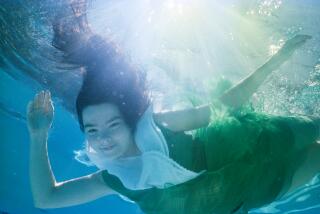‘Oceans:’ Cold-water diver photographs marine wonderland
- Share via
For Eric Börjeson, one of the underwater cinematographers on “Oceans,”a Disneynature film on the subaquatic realm, swimming in ice water is as natural as breathing out of a scuba tank.
“It’s very normal for us in Scandinavia because even in the summer we have to dive as cold-water divers,” he said. “That means that we use a dry suit. Around the face and hands it has a neoprene seal, and then the boots are integrated, so there’s no point where water can enter. Since I’m from a colder country, Sweden, ‘Oceans’ tended to send me out on colder shoots. I did the shoots in the Arctic and in Antarctica.”
Diving is in Börjeson’s blood. His father helped salvage and photograph the Vasa, a sunken 17th century warship, in Stockholm.
“I always knew that underwater there is a lot of history to tell,” said Börjeson. “For me, it was a part of how I grew up.”
After receiving his first camera at 16, it was only natural that Börjeson would later wind up donning a pair of flippers and shooting underwater scenes for Swedish feature films. Given the opportunity to film animals, he dove right in.
“Some 10, 15 years ago, orcas started to enter the narrow fjords of Norway,” he recalled. “And since I knew about diving and photography, I just took a chance and went up there. Back then, we didn’t really know how to dive with orcas, but we went in and tried to swim with them as if they were ordinary dolphins. And we found out that they’re just friendly and beautiful.”
On “Oceans,” Börjeson took this several steps further as he traveled from the frozen poles to the milder climes of South Africa, Costa Rica and Cocos Island, encountering everything from walruses to whales. “Curiosity is actually what’s driven me more than anything,” he said.”
Bubble head: On “Oceans,” Börjeson mainly employed a technique called rebreather diving. “Rebreather is a closed-circuit system, so the air that you exhale gets filtered and then reoxygenated, and you breathe it in again. There are a lot of advantages with it, because you don’t leave any bubbles in the water, so you can be in a stealth mode. For example, hammerheads can be really shy at this location at Cocos Island [about 300 miles off the coast of Costa Rica] because they are there to get cleaned by small fishes, so it’s really a relaxing moment for them. We saw 100 at the same time but to get to that moment with hammerhead sharks, we really had to hide in the rocks and absolutely leave no bubbles going up to the surface.”
Delicious fishes: Even outside of cans, sardines can find themselves packed. “We shot in what is called the ‘sardine Run’ in South Africa in a province called KwaZulu-Natal,” said Börjeson. “And it’s a major event where a lot of sardines congregate on the coast, and the dolphins start to feed on them. So what the dolphins do is go down at depth, and start ‘bubble netting’ [the sardines], which is surrounding them and scaring them up with bubbles that they let out from their blowholes. So a ‘bait ball’ of sardines is pushed to the surface and the dolphins start to feed from it. Gannet birds start to dive from the sky. And then after a few minutes, we start to get the sharks. So what we get is a fantastic mix of animals, and that’s really action. There was one that ended up with a whale actually coming up from below and just opening his mouth and eating the whole bait ball.”
Chilly disposition: Like actors, animals have their unique personalities. “The animals are extremely shy in the Arctic while in the Antarctic, they are all the opposite,” Börjeson said. “In the Antarctic, they have no concept of humans being bad. They just looked at me. I was shooting a seal giving milk to its cub on the sea ice. And I was putting up my tripod and doing the shot, and I was two meters away from it. That would never happen in the Arctic. In the Arctic, the seals are afraid because of polar bears, and the local Inuits actually hunt them. So a seal would escape into the ice hole if I got closer than 100 meters away from him. I ended up doing the polar bears in the Arctic. The Arctic is an extremely interesting place to shoot but it’s very difficult.”
Blast off: It wasn’t easy to keep up with the fishes. “We had high-speed camera rockets to have the camera move as fast as dolphins underwater,” said Börjeson. “We had what we called a camera torpedo that was towed behind a boat to move with the schools of dolphins. Above surface, we had unmanned mini-helicopters with the camera remotely controlled. We had specifically invented and constructed a gyroscope to be able to shoot with a steady horizon while moving through waves on the open sea. So we’re talking about a lot of inventions, constructions and special equipment. It was crazy and very visionary.”
More to Read
Sign up for The Wild
We’ll help you find the best places to hike, bike and run, as well as the perfect silent spots for meditation and yoga.
You may occasionally receive promotional content from the Los Angeles Times.






